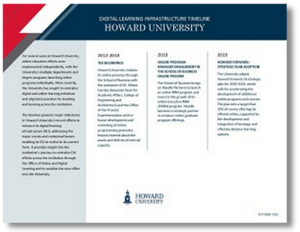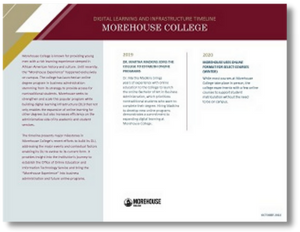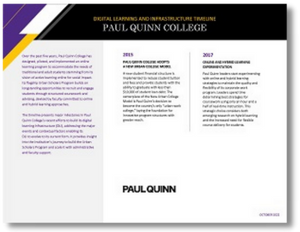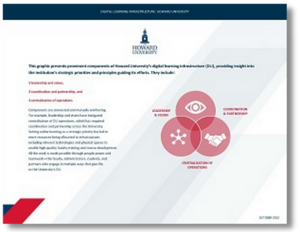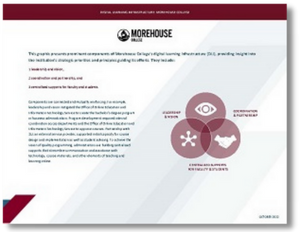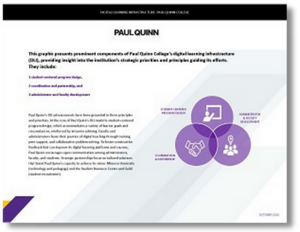by Kimberly Braxton, Director, Equal Measure
More than two years ago, postsecondary institutions across the nation were thrust into emergency remote instruction to keep classes going amid the COVID-19 pandemic. Before this inflection point many had named online and hybrid programming a strategic priority for increasing student access to career pathways in high-demand fields. It is in this context of rapid change and economic turmoil that Historically Black Colleges and Universities (HBCUs) have been charting their own futures—working to sustain their unmatched ability to provide an integrated academic, social, and cultural experience for Black students while also strengthening their digital learning infrastructure (DLI) to fully serve students, including those with families and full-time jobs, who have grown accustomed to operating in virtual environments.
The pandemic and the racial unrest stemming from the murder of George Floyd, Breonna Taylor, Ahmaud Arbery, Walter Wallace, and so many others have centered attention on these valuable yet historically underfunded institutions—and sparked efforts to ensure that HBCUs not only survive but also thrive in digital learning. During 2021, the Bill & Melinda Gates Foundation provided Digital Learning Infrastructure Capacity and Knowledge Sharing grants to Howard University, Morehouse College, and Paul Quinn College as part of a larger body of work (including UNCF’s HBCUv initiative) to integrate racial equity as a principle into the foundation’s grantmaking and to develop an investment strategy grounded in a co-design process with HBCUs. HBCUs have used their 12-month grants to enhance existing DLI efforts, such as centralizing digital learning initiatives and expanding online and hybrid programs.
In 2022, Equal Measure partnered with the three HBCUs to document these efforts and share what we are learning. The knowledge that has emerged is informing philanthropic strategy and awareness about digital learning infrastructure that drives success for students attending HBCUs and equitable student success in higher education more broadly.
In this first of a three-part series, we present major milestones in each HBCU’s recent DLI efforts, addressing the driving forces and context relevant to current initiatives. We present the core components of each institution’s digital learning infrastructure, highlighting the priorities that drive the institution’s individual approaches. Below we share a few cross-institutional highlights, which are relevant to many types of postsecondary institutions.
Understanding the “HBCU context” for digital learning
Cultural relevance through courses and campus activities that promote affirmation and celebration of African American history and culture
Proactive advising and mentoring through faculty and staff “going the extra mile” to make students feel cared for and to cultivate an environment that promotes college persistence and completion
Sense of community and belonging through being among peers, faculty, and staff who look like you and have similar cultural backgrounds, rather than being a “minority” in predominantly white settings
Financial hardship among students is common, and institutions recognize that college needs to be affordable because Black students are disproportionately at risk of not having the material assets they need
Operating as under-resourced organizations caused by systemic racism means that HBCUs are constantly managing financial limitations while planning and executing their strategies
Timeline of DLI Efforts: Four Reflections on the HBCUs’ Journeys
- Everyone starts somewhere: experimentation, trial, and error. The institutions set strategic priorities for digital learning, and all worked through an early phase of piloting online programs, learning from their experience, and assessing internal strengths and vulnerabilities. Piloting and feedback loops have been critical components enabling continuous improvement.
- The COVID-19 pandemic accelerated DLI efforts. Many instructors became more open-minded about online learning and shifted their instructional practice when they were required to teach remotely. This new teaching experience demonstrated that they could virtually deliver content and engage with online tools in effective ways—especially when they worked to improve their practice over time. Administrators and students learned to operate remotely as well. However, members of the school community continued to crave the sense of community and belonging that comes naturally being on an HBCU campus.
- Increasing capacity to meet the demand for digital learning is necessary—particularly by working with external partners and hiring DLI experts to shepherd institutional efforts. The institutions have recruited new staff with relevant skills and experience to take their DLI efforts to the next level, strengthening the quality and expanding the scale of their offerings. Partnerships with providers like 2U and Minerva University bolstered capacity by providing services related to course design, technology, marketing, and online program management.
- Moving past emergency remote instruction has created space for expanded online and hybrid programming that center quality. Institutions are leveraging the Quality Matters framework to ensure programs meet and exceed online learning standards. The HBCUs are exploring ways to scale and expand programming, including by migrating traditional certificate and degree programs to online opportunities. In-person experience, like fieldwork placements, can complement online coursework. They are also working to bring their campus cultural traditions to virtual spaces to build meaningful connections between faculty and students.
DLI Core Components: Four Reflections on the HBCUs’ Digital Learning Infrastructure
- Institutional leaders must set a vision for digital learning. Provosts, chiefs, and deans align on DLI priorities and allocate appropriate resources to the initiatives. While DLI efforts may emerge in pockets across the institution by highly motivated faculty, the work needs to be embedded in organizational strategy to enable coherence and follow-through on action plans.
- Digital learning efforts require everyone’s participation and engagement. Not only do various offices across the institution need to break out of silos to forge the connections that make online and hybrid programs work, but to ensure that it meets the needs of the “end users.” While not essential in all cases, online program managers carry out critical functions of the digital learning infrastructure—and to maximize their value, they must be responsive to administrators, faculty, and students.
- Faculty need ongoing support. Institutions have invested heavily in faculty professional development and learning communities to ensure that faculty have the information and resources to teach well in the virtual environment. Over time, technological changes to learning management systems and other tools require training and technical assistance, as well as space to share their experiences and learn from each other.
- Streamlined, effective communication cuts across DLI components. Faculty, students, administrators, and partners need reliable mechanisms to exchange information before classes launch, while they are in session, and after completion. The technological elements of digital learning should not overshadow the relational elements of interpersonal connection and communication, especially between faculty and students.
These are just a handful of insights about the DLI journeys and capacity building work led by Howard University, Morehouse College, and Paul Quinn College. In the next post, we share reflections from Morehouse College students and faculty on their online program experiences. The final post presents profiles of each institution’s recent digital learning efforts, elevating lessons learned from implementation.
